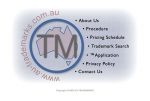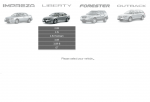
 This was a somewhat frustrating design, in that it started out salvaging another design that was abandoned about a week after it went live. Not that there was anything wrong with the design, the client had a change in business relationships, so their site was redirected to promote them exclusively. You can also see an image gallery of the variations the site went through, which to my eye, all looked nicer than what eventually went live.
This was a somewhat frustrating design, in that it started out salvaging another design that was abandoned about a week after it went live. Not that there was anything wrong with the design, the client had a change in business relationships, so their site was redirected to promote them exclusively. You can also see an image gallery of the variations the site went through, which to my eye, all looked nicer than what eventually went live.
Main : Timeline
Pinned and chronological feed of posts.
mayfly cycle
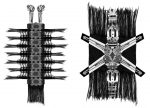
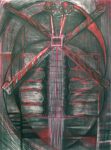 These works were the core of a project based around using computers in art. Now, as someone who works digitally a lot of the time, I actually think they’re a terrible artistic tool since the crutch of “undo” robs people of any risk while creating works. Never having to risk destroying a work to progress it, I think is going to create risk-averse artists. But that’s a rant for another time.
These works were the core of a project based around using computers in art. Now, as someone who works digitally a lot of the time, I actually think they’re a terrible artistic tool since the crutch of “undo” robs people of any risk while creating works. Never having to risk destroying a work to progress it, I think is going to create risk-averse artists. But that’s a rant for another time.
The basic premise was to scan some real world objects, and combine those with scans of our sketches done of the machine part templates, and then use photoshop to composite the parts. I ended up scanning my scarf, and watch. Some of these digital pieces were combined with crayon drawn on acetate overlays, but the final product was to take them and retranslate to a charcoal drawing.
This second piece was begun by covering the entire sheet in charcoal and compressed charcoal marks, then begin cutting the image out with an eraser, then go back in with charcoal and pastel, over and over building up a depth of texture to get to a dense image.
The bits of text on it are sequences of random numbers, done with one of those adjustable rubber stamps. And when I say random numbers, I was in the studio with my laptop running a random number generator. Hit the button to generate the number, adjust each digit on the stamp, ink, stamp, hit the button again. Very laborious, but a really satisfying result. This is one of my favourite pieces of 2007. It’s a little under A1 in size.
austral distributing
 This is a very old site, predating my use of CSS for typography. I still like it for the design itself though, especially the “products” page.
This is a very old site, predating my use of CSS for typography. I still like it for the design itself though, especially the “products” page.
Even by today’s standards, it’s got that “web 2.0”-ish look to it, rounded corners and all. Really, all it needs is a bunch of superfluous reflections, and to be missing a few vowells from the name.
au-trademarks
msb credit union
 The Maritime Services Board Credit Union site. Hence, the general wharf / jetty theme.
The Maritime Services Board Credit Union site. Hence, the general wharf / jetty theme.
Sadly this site barely made it online before they merged with another credit union and it was mothballed. Once you go into the “products” section it has a really nifty animated menu system. This site also has a completely liquid design, able to resize to any browser window.
It’s a product of its era, in which frames was the only technology that could accomplish the design. Today, a simple CSS technique would achieve the same result.
subaru menus
lifemodel on a donkey
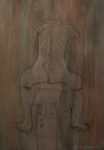 This was from a life drawing class, and was one of my early uses of black and white on pre-stained paper. I think the volumetric modelling on the lower back ended up working really well, and the fading detail through the head provides some depth. I’ll try to get some more life pieces up over time. They’re A1 in size, and stained with a combination of burned sienna and black washes.
This was from a life drawing class, and was one of my early uses of black and white on pre-stained paper. I think the volumetric modelling on the lower back ended up working really well, and the fading detail through the head provides some depth. I’ll try to get some more life pieces up over time. They’re A1 in size, and stained with a combination of burned sienna and black washes.
st. mary’s cathedral
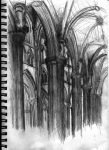
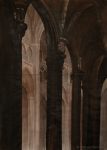 This was done on the basis of sketching at St Mary’s cathedral in Sydney. The initial sketching was somewhat amusing. I was sitting in a corner on the floor drawing away, and an old lady brought a tour group of private school boys past (I’m there in boots, dreadlocks and tartan pants) and she comments “now we won’t disturb the artist there” and then proceeds to explain some chapel I’m sitting next to. I looked around for a sec for this “the artist” before I realised se meant me. Kinda made my day, actually.
This was done on the basis of sketching at St Mary’s cathedral in Sydney. The initial sketching was somewhat amusing. I was sitting in a corner on the floor drawing away, and an old lady brought a tour group of private school boys past (I’m there in boots, dreadlocks and tartan pants) and she comments “now we won’t disturb the artist there” and then proceeds to explain some chapel I’m sitting next to. I looked around for a sec for this “the artist” before I realised se meant me. Kinda made my day, actually.
So, the big finished work is A0 in size, and was scaled up by hand using diagonal quadrants. It’s done in a combination of burned sienna and black ink, and I think is the beginning of my love affair with these to colours. There’s also some wax resist in there, where you draw with wax on the paper to repel ink from parts. Overall I think it’s strength is the layers of contrast which draw the eye through the piece, the virtual silhouetting of the foreground, the somewhat dreamy loose midground, and then he deep shadows heading off into the transept. Hopefully you get a feeling for the almost forest nature of the gloom and columns.
orange still life
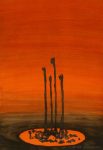 One of two quick and dirty A3 portfolio stuffers done prior to assessment at midyear for the Table project. It’s a still life, based on the same object used for the flying pieces in the cityscape. What’s remarkable is how evocative the orange feels of Aboriginal / central Australian colours – it was commented on by a number of people.
One of two quick and dirty A3 portfolio stuffers done prior to assessment at midyear for the Table project. It’s a still life, based on the same object used for the flying pieces in the cityscape. What’s remarkable is how evocative the orange feels of Aboriginal / central Australian colours – it was commented on by a number of people.
I may very well work on some more variations on this piece, since I really like the way the tall extensions almost seem extruded from the substance on the ground plane. Viewed upside-down it looks like they’re dripping down.
cityscape still life
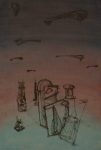 This was the second Table piece, again based on sketches of the machine part templates. It’s another piece around A2 in size. The background stain was done over a few days, building up colour after colour. On an aside, these watercolour pieces aren’t a perfect reflection of the actual works – watercolour has an amazing variability depending on the lighting conditions it’s being viewed under, mainly due to the mechanics of light refraction and reflection within the layers of paint. You really need to see them under true sunlight, the downside being sunlight degrades the pigments eventually.
This was the second Table piece, again based on sketches of the machine part templates. It’s another piece around A2 in size. The background stain was done over a few days, building up colour after colour. On an aside, these watercolour pieces aren’t a perfect reflection of the actual works – watercolour has an amazing variability depending on the lighting conditions it’s being viewed under, mainly due to the mechanics of light refraction and reflection within the layers of paint. You really need to see them under true sunlight, the downside being sunlight degrades the pigments eventually.
The actual idea with this was to mess with scale and try to work very small, so having filled the bottom, knowing what to do for the top was a bit of a mystery. The long bone-like template came to the rescue, and so it ended up being reminiscent of a steampunk type vista of airships over a city.





